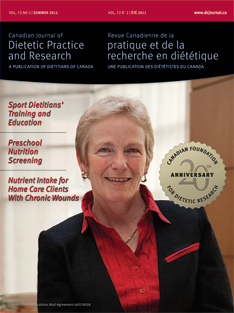Abstract
Purpose: Dual energy X-ray absorptiometry (DXA) and air displacement plethysmography (ADP) are commonly used to assess body composition. Accurate body fat measures are valuable in a variety of populations. Because DXA, the reference standard, is expensive and labour-intensive, determining whether these two methods are interchangeable is important.
Methods: Forty-five female undergraduate students aged 21 to 33 with body mass indexes of 18.3 to 28.6 kg/m2 were recruited from the University of Guelph. Each participant underwent one full-body DXA scan and one ADP assessment, to determine total percent fat mass (%FM).
Results: The Pearson's correlation between %FMDXA (27.1 ± 4.8) and %FMADP (26.1 ± 5.5) indicated good association (r=0.88, p<0.01). While Bland–Altman analysis revealed no systematic bias between the two methods (R2=0.07, p=0.08), large intraindividual variation occurred (95% confidence interval: -5.86% to 4.11%); this was related to height, weight, body-surface area, and lung volume.
Conclusions: The two methods were significantly correlated. Mean %FM was not significantly different and no systematic bias between methods was observed. These findings indicate that ADP and DXA may be used interchangeably for determining %FM at the group level in healthy young women; a large intraindividual variation between the methods precludes interchangeability at the individual level.
Résumé
Objectif: L'absorptiométrie à rayons X en double énergie (DEXA) et la pléthysmographie par déplacement d'air (PDA) sont des méthodes couramment utilisées pour l’évaluation de la composition corporelle. Puisque des mesures précises du tissu adipeux revêtent une importance particulière chez diverses populations et que la DEXA, la référence en la matière, est coûteuse et exigeante en main-d'oeuvre, il est important de déterminer si ces méthodes sont interchangeables.
Méthodes: Quarante-cinq étudiantes au premier cycle (21 à 33 ans, 18,3 à 28,6 kg/m2) ont été recrutées à la University of Guelph. Chaque participante a subi un examen DEXA sur l'ensemble du corps ainsi qu'une évaluation par PDA afin de déterminer le pourcentage total de masse adipeuse (%MA).
Résultats: Le coefficient de corrélation de Pearson entre le %MADEXA (27,1 ± 4,8) et le %MAPDA (26,1 ± 5,5) a indiqué une bonne association (r = 0,88, p < 0,01). L'analyse de Bland- Altman a révélé qu'il n'y avait pas de biais systématique entre les deux méthodes (R2 = 0,07, p = 0,08). Toutefois, il y avait une importante variation intraindividuelle (IC à 95 % : - 5,86 % à 4,11 %). Celle-ci était associée à la taille, au poids, à la surface corporelle et au volume pulmonaire.
Conclusions: Les deux méthodes étaient significativement corrélées. Le %MA moyen n’était pas significativement différent, et aucun biais systématique n'a été observé entre les méthodes. Ces résultats indiquent que la PDA et la DEXA peuvent être utilisées de manière interchangeable pour déterminer le %MA d'un groupe de jeunes femmes en santé. Toutefois, l'importante variation intraindividuelle entre les deux méthodes rend ces méthodes non interchangeables pour les évaluations individuelles.



